2025 Wines in Detail
updated 11/11/2025
As with last year, this will be an on-going blog of the wines started in 2025. Currently I’m on an annual cycle, starting grape wines in the fall.
This is not any assurance that things will remain on this schedule.
Dates of Activity
| 09/13/2025 09/14/2025 09/15/2025 09/16/2025 09/21/2025 09/22/2025 |
10/04/2025 10/25/2025 11/01/2025 11/09/2025 11/11/2025 |
. |
Winemaking Notes
My normal winemaking notes for each batch are here:
09/13/2025
For us, the 2025 grape season officially started today. We are purchasing Chardonnel, Baco Noir, Marechal Foch, and Leon Millot.
My elder son and I drove 4 hours to the Glade Spring VA vineyard of our friends Beth & David. It’s a long drive, especially since we have to drive home afterward, but it’s worth it. The wines we have produced from their grapes in the last 2 years are great!
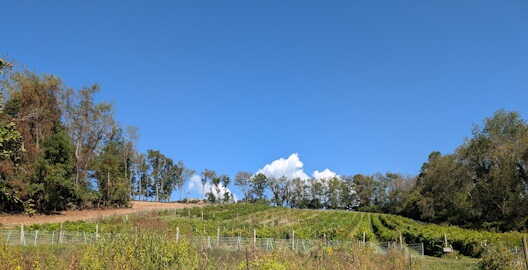
They are expanding their vineyard, as shown in the picture. Clearing equipment is visible at the top of the hill. They will be expanding the planting of certain varietals, including Chardonnel. More on that later.
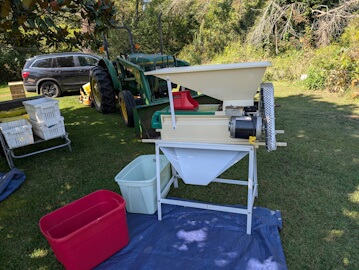
Beth and David were ready to rock when we arrived just before 11:00 AM. What we have done in previous years is crush the grapes that Eric, Shannon, and I are buying, then we crush whatever grapes Beth and David have for themselves.
Winemaking is a shared activity, every step of the way. I made wine on my own for decades, and it is FAR more fun as a group activity. Eric & I are pleased to help Beth & David to crush whatever they have.
It’s unfortunate that we don’t live closer to Beth & David, so we could do more during the year. But? Enjoy what you have.
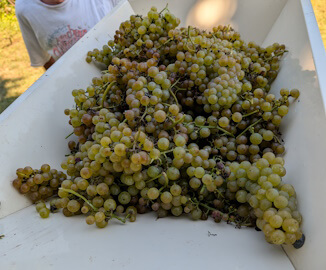
First we crushed Chardonnel. These look beautiful.
We wanted 130 lbs, to produce a bit more than two 19 liter (5 US gallon) carboys of finished wine. With our younger son and his family moving back to the area, we have a fourth person in our winemaking co-op, so that means one case of wine each.
Side Note: For the average person a case (12 bottles) of wine is a lot. For many winemakers? It’s not.
Each wine is a unique endeavor, never to be repeated. When it’s gone, it’s gone.
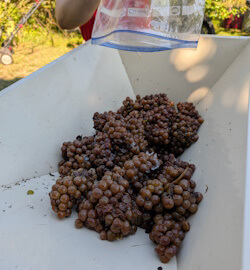
This is far different from purchasing commercial wine, where the vendor may produce 100,000 cases. Plus they blend for consistency, year to year, so the consumer is always getting a similar wine.
Ok, off my soapbox.
Last year we took all but 40 lbs of Chardonnel, so Beth & David froze the remaining 40 lbs. This year yields were down, so they had less than we wanted. So … they pulled out the frozen grapes, and we added it in. The grapes look ugly after defrosting, but that is not a problem.
Last year Beth & David froze the Chardonnel for several weeks, as we were coming in early October to crush the Chambourcin and Chelois. So we crushed defrosted Chardonnel, and the wine turned out very pleasing.
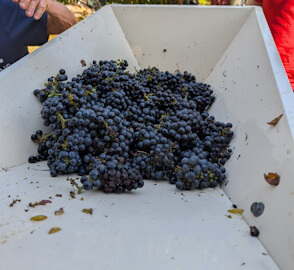
Next we crushed 25 lbs each Marechal Foch and Leon Millot. The overall target is 250 lbs of grapes (200 lbs Baco Noir), so we are field blending in about 10% each of Foch and LM. Ideally we would made separate batches of all 3 grapes and blend after 3 to 6 months, but available space doesn’t allow for that. Plus we need to fill the barrel, and we won’t have enough Baco to do that. So we field blend.
I cannot recall if the grapes in the photo are Foch or LM. I think they are Foch, but it doesn’t matter. Both grapes were beautiful.
Beth was concerned about the quality of the Baco, but it all looked good.
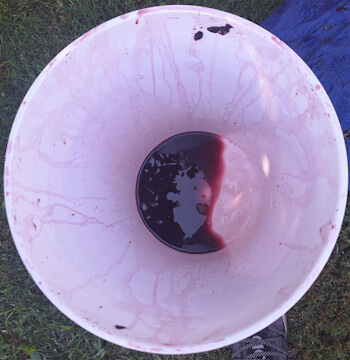
Something to note is that Baco and Foch are “teinturier” grapes. This is a French term — I’ve listened to the pronunciation numerous times, and I just cannot correctly say the first syllable, so I stopped trying.
Most red grapes have white flesh and juice — the color comes from the skins. Teinturier grapes have red flesh and juice, and the wines can be very dark. This photo shows residual juice in a bucket. Non-teinturier red grapes may have some color at this point, but no where near this much.
The grapes mostly fit in the 20 gallon Rubbermaid Brutes we use for fermentation. We have purchased 23 liter juice buckets the last couple of years, and to my mind this is 23 liters of juice with a free bucket. We save the buckets, as they are very useful!
The grapes would fit in the Brutes, but it made them a bit too full. This means they are harder to lift into and out of the vehicle, and that I have concern should I have to stop suddenly. Moving some of the grapes into the buckets relieved this concern.
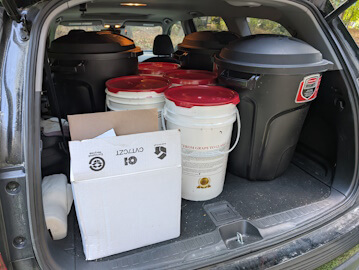
I drive a Honda Pilot, and with the third row seats folded down, we had plenty of room. It’s best to have the area full, so in case of a sudden stop, the containers have little room to shift.
The box is wine that Beth and David gave us. We always exchange bottles.
This time we brought bottles of our 2024 Chardonnel and Vidal, and 2023 “Chianti” (Sangiovese juice fermented with pomace from Cabernet Sauvignon, Cabernet Franc, & Merlot). Plus a bottle of “Port” we constructed using the Chianti, enough EverClear 151 to raise the ABV to 20%, sugar, and glycerin.
We taste their Foch and Baco, both of which are quite good. This bodes well for our wines! We also tried our Chardonnel and Vidal, which came out very good. And we tasted their 2024 barrel-aged Cayuga, which makes me want to find a 6 to 8 US gallon barrel for whites. Note on tasting — as the driver my sample were small, just enough to taste. No way I’m getting on the road with any appreciable amount of wine in me. That would be absolutely stupid.
When we got home we unloaded the grapes into the cellar and did nothing else. We had enough fun for one day.
09/14/2025
This morning I did a final weighing of the grapes. We have 120 lbs Chardonnel and 260 lbs of Baco Noir. [The Baco is field blended, but it’s far less tedious to just call it “Baco”.] Perfect!
I made 3 yeast starters with 71B, Avante, and Bravo. Eric & I discussed it during the drive, and we changed our mind on RC-212, which will be used on the Pinotage we will be buying a few weeks.
Each container of Baco received 2 cups medium toast American oak chips for fermentation oak. All three containers received 15 to 16 g Fermaid-O nutrient.
This year we are trying Go-Ferm Sterol Flash rehydration nutrient, so I followed the instructions. Each starter received 15 g Go-Ferm and 5 tsp yeast. Each batch should made approximately 10 to 12 US gallons, which means each requires two 5 g packets. Each packet is about 2 tsp yeast. Since yeast is cheap (ours is all in bulk), I added an extra tsp to each starter.
To each starter I added 6 oz water at 95 F, let it set for 20 minutes, then swirled each to mix and poured it gently along the side of the respective fermenters.
All that was left to do was the un-fun part — cleanup!
09/15/2025
This morning all containers were actively fermenting. I stirred each 3 times during the day.
09/16/2025
Fermax has been the yeast nutrient I’ve used for a very long time. Two years ago I ordered Fermax yeast nutrient from an Amazon vendor, and received DAP instead. When I complained to Amazon, they refunded my money and said to keep the product. I was ok with that.
First, a quick primer on DAP and YAN:
YAN (Yeast Assimilable Nitrogen) is a component of yeast nutrition. It provides nitrogen which stimulates the fermentation process.
DAP (Di Ammonium Phosphate) is a common source of YAN, but it has a bad reputation as “crack for yeast” in that yeast consumes it too rapidly, making a faster fermentation that may introduce off flavors. Many pundits favor other nutrients, which makes sense as the proprietary nutrients I’m familiar with contain other substances that are beneficial to yeast.
Since I have the DAP, I’ve been using it as part of the nutrient, typically in the final dosage. It’s recommended to add nutrient in 2 doses, with 2/3 added at inoculation, and the remaining 1/3 when the sugar is depleted by 1/3, e.g., if the OG was 1.090, the second dose would be added at roughly SG 1.060. Alternately, some sources recommend adding the second dose 48 hours after inoculation, which when using a yeast starter, is roughly at 1/3 depletion.
This year I’m trying something difference. Lallemand Fermaid-O, another proprietary nutrient blend, doesn’t contain added DAP and supposedly causes a cooler ferment which is less likely to produce sulfur compounds such as H2S. A lot of folks on WMT recommend it.
For the first nutrient dose, I used Fermaid-O.
Today is 48 hours after inoculation and I did not bother checking SG, I just added nutrient.
As mentioned above, I have about half a jar of Fermax and a bit less than that of DAP. I mixed the two well, and used that for the second dose. I cannot say this was the best choice, but it’s the one I made.
When we make the Pinotage in a month, it will be fermented in 2 batches. I’m considering using Fermaid-O in one and the Fermax/DAP blend in the other, so I can directly compare the two.
09/21/2025
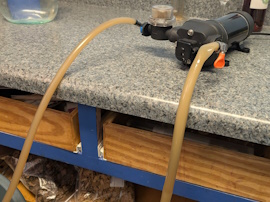
Pressing day!
I punched down twice or 3 times each day, but didn’t check SG. The wines were fermenting well, lots of activity during punch downs. We planned to press today, based upon getting everyone schedule together. It didn’t matter what the SG would be. We try to work according to the wine’s schedule, but sometimes ours take precedence.
In this case, pressing yesterday or in the next days wouldn’t work, so today is the day.
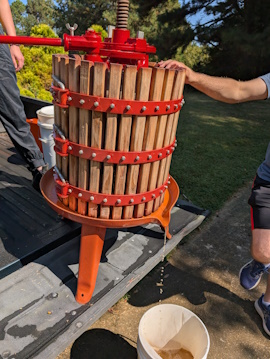
We started by pumping as much wine from the Chardonnel as possible. We have to carry the fermenter out of the cellar, through the house and garage, to the drive. Pumping wine out means we don’t have to carry the free wine. We are also not simply pouring wine through the press. Overall, it’s a good idea.
Our press is a #40 basket press. “#40″ means the inside diameter of the basket is 40 cm, which is roughly 16”. The press capacity is 18.5 US gallons, which is a bit larger than the largest batch we have made (300 lbs). This batch is 120 lbs.
The base of the press is heavy steel. It’s best to use two people to lift it, especially as it’s an awkward burden. “Press blocks”, curved wooden pieces go on top of the grapes. On top of that we layer numerous wood blocks as spacers. On top of that is a large block of wood with a hole in the middle for the spindle to pass.
The ratchet touches this, and the wood is grooved from many pressings. If the ratchet touches the blocks, it would move them, so this block prevents that.
Also note that the pressing stops when the ratchet hits the basket. The various blocks act as spacers between the grapes and the ratchet.
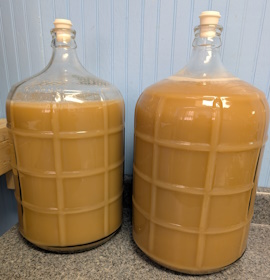
The ratchet is cast iron, and very heavy. Its weight alone will start the pressing. [I need to weigh it, just to satisfy curiosity.]
We pumped the wine into a Brute in the cellar, and the pressings were added to it.
Today’s pressing produced about 9 raw gallons of Chardonnel. We were hoping for a bit more, but this is satisfactory. Note that yield will vary from year to year, depending on growing conditions and other factors. We expect that after clearing we will move this into a 19 and a 12 liter carboy.
The SG is 0.997, so the fermentation is either done, or close to it.
Eric recorded notes from tasting the wine, something we do every time we touch it:
Very acidic, Good bones.
The wine is acidic because of 3 acids: tartaric, malic, and carbonic. Over the winter some excess tartaric acid will drop out of solution as tartrate crystals. We will inoculate with MaloLactive Bacteria in the near future, and the bacteria will convert the harsher malic acid into lactic acid.
The carbonic acid is due to dissolved CO2. As this dissipates, the carbonic acid will go away. Overall, the final wine will be less acidic.
The “good bones” comment refers to the body. This is a heavier white and should have a longer shelf life.
Next we press the Baco Noir. This batch is 260 lbs of grapes, so it will fill the press more. It was fermented in 2 batches with Avante and Bravo yeast, respectively. More on that later.
As with the Chardonnel, we pumped the wine from beneath the grapes. This makes a huge difference. The following picture shows just how much wine is removed, meaning we don’t carry it up to the driveway, and later back down.
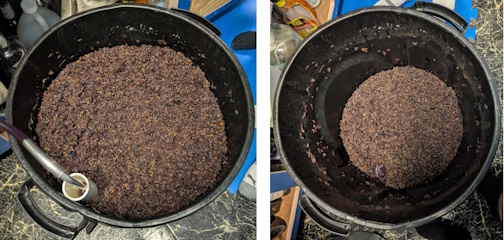
After pressing the “cake”, the compressed pomace (grape solids) is a significant thing.
We didn’t press the Baco as hard as the Chardonnel. We probably left 1 to 2 gallons of wine in the pomace.
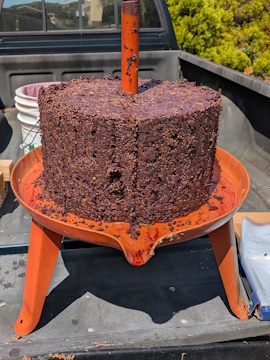
Why?
A common practice is to make a “second run” wine from the red pomace — add water, sugar, and acid to make a second wine, one that is lighter in body and ages faster. Sometimes this produces a fairly nice wine, but sometimes the wine is disappointing.
The last few years we have adopted the practice of using red juice buckets instead of water. This produces a wine more robust than either a typical second run wine OR wine from juice buckets.
In a month we will receive our California grapes and juice. The grapes are Pinotage and the juice is two 23 liter buckets of Pinot Noir. To fill a barrel we need an additional 4 gallons of wine, so we leave some in the pomace when pressing. This works out very nicely!
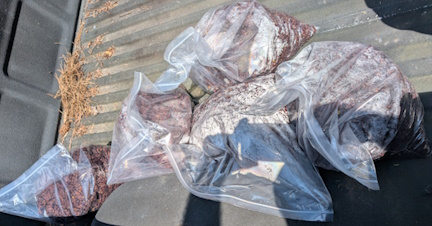
After pressing the Baco, we moved the pomace into 3 gallon ziplock bags, and put them in the freezer. When the Pinot Noir juice buckets arrive, we’ll defrost the pomace and add to the buckets.
Normally we don’t add yeast, as the pomace is full of it, but this time we may make a yeast starter, simply to ensure that our choice of yeast is the one that wins.
Another thing — we have not added K-meta yet, as we intend to inoculate the Chardonnel and Baco Noir with Lalvin 31 MLB. This will be done after the Pinotage and Pinot Noir batches are pressed. The MLB packet treats up to 66 gallons of wine, and it’s a small amount of material.
What we did last year is rehydrate the MLB (as per directions) and divvied the liquid between batches, according to batch size. We’ll do the same this year.
Note: We are also making 2 buckets of Italian Verdicchio. This wine will not receive MLB, but the other 4 (Chardonnel, Baco Noir, Pinotage, Pinot Noir) will.
Eric’s note from tasting the Baco are more extensive, as we tasted the batches fermented with Avante and Bravo against the combined wine. Note that this wine has NOT yet completed fermentation, and it’s surprisingly good. Eric, Anastasia, and I shared a glass, we liked it that much.
Avante: Flavors of blackberry & plum.
Bravo: More acidic. Flavor of blackberry, some tannin (more robust).
Combined: Much more tart, tannic (more body), acidic fruit at the end. This is the favorite.
Avante eats 25% – 30% of the malic acid, which makes a huge difference at this time. We will inoculate with MLB and the wine will drop tartrate crystals over the winter, so the acid level with drop. We have high hopes for this one.
09/22/2025
The initial clearing of the wine, especially whites, happens quickly. The photo shows the Chardonnel and Baco Noir a bit more than 24 hours after pressing.
Last year the Vidal and Chardonnel both displayed some protein haze, which was treated with a light dose of bentonite. If this year’s Chardonnel displays a haze, we’ll do it again.
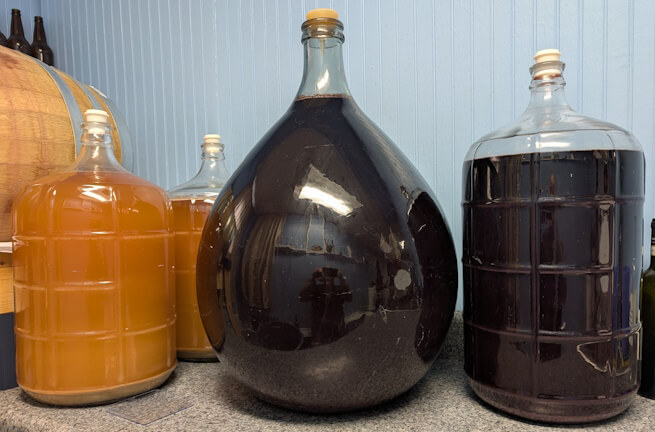
10/04/2025
Yesterday we bottled the 2024 Pinot Noir, which has been in barrel at my elder son’s home since last fall. It’s time to barrel the Baco Noir, and all gets done at once.
My younger son & I racked the Baco Noir from the 55 liter demijohn and 19 liter carboy into buckets for transport to my elder son’s home. It will go into his barrel. Plus we loaded my vehicle with a 20 gallon Brute, transfer pump, AiO pump, corks, etc.
At his house, we racked the Pinot Noir using the transfer pump. Something was wrong with the setup, as the output joint leaked. But we muddled through. I’m not going into detail in the bottling, which is described in the 2024 Wines in Detail post.
Next we rinsed the barrel, and emptied out the oak cubes. These will be dried and saved for use in the smoker! Then we added 7 oz Barrel Oxyfresh to the barrel and filled it with water. This soaked while we bottled the Pinot Noir.
After cleanup from bottling, we emptied the barrel and transported it do my son’s new home. A 55 liter barrel is heavy and while it’s possible, we had NO interest in trying to transport it while full!
At the house, it was a simple matter to place the barrel, setup the transfer pump, and fill the barrel.
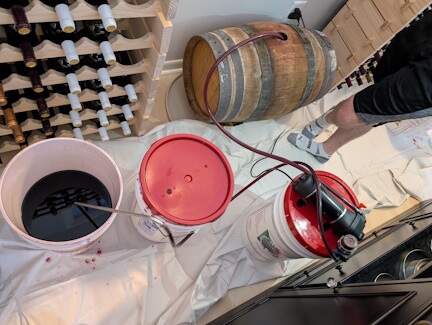
We have 5 more gallons leftover after filling the barrel, so I transported that home, and racked it into a 19 liter carboy. In a few days this will be moved into 4 liter jugs, and some into 750 ml bottles. The bottles will be used for barrel topup.
10/25/2025
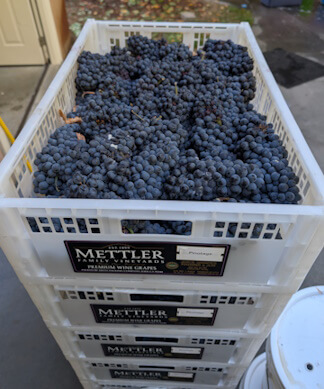
Today we crushed our California grapes and picked up the juice buckets.
The Pinotage looks very nice. Very tasty, too.
There was a few minor incidents of mold, indicating the grapes had been in cold storage a week. This is one of the things we have to deal with to get California grapes.
A few years back the Tempranillo had a lot of mold, which is apparently a type that grows in cold storage. It’s not something from the field.
In the case of the Tempranillo is was bad enough that we had to toss the worst clusters. I then hit it with K-meta, and again the next days. The good news is the Tempranillo turned out fine.
Regarding the Pinotage, it was specks of white mold on a handful of clusters. I do not expect it will be a problem.
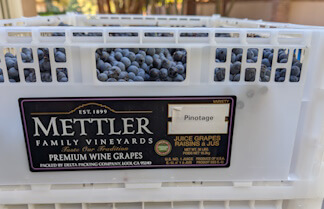
We crush in 2 lug groups, with a large container under the chute. Each lug is 36 lbs (16.3 kg), and we do the grouping for weight. After 2 lugs we pour the grape pulp into a Brute 32 gallon Brute for transportation and later fermentation.
Yeah, we can pick up larger amounts, but for ease of effort, 72 lbs (32.6 kg) is better.
Each Brute gets 4 lugs (144 lbs, 65.3 kg). Lifting this is easily done by 2 men (me and either of my sons). The Brute can contain a larger amount, but it becomes more unwieldly to manage.
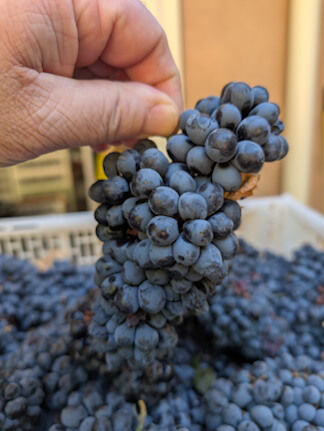
Another consideration is body mechanics and place undue strain on the body. I’m no longer a spring chicken, and with each year the possibility of hurting myself by trying to lift too much becomes more likely. So I try to do this wisely.
Back to discussing the wine.
Often I add potassium metabisulfite (K-meta) at this point, but we intend to inoculate for malolactic fermentation (MLF), so that hasn’t happened yet. Malolactic bacteria (MLB) reacts poorly to sulfite, so I don’t add K-meta until after the MLF has completed.
There is a danger of premature fermentation, although the vendor (Gino Pinto) keeps the grapes and juice at 35 F (1.7 C) so that’s not normally a problem prior to us receiving the buckets. Fermentation (yeast eating sugar) can occur at that temperature, but it’s very slow if it occurs.
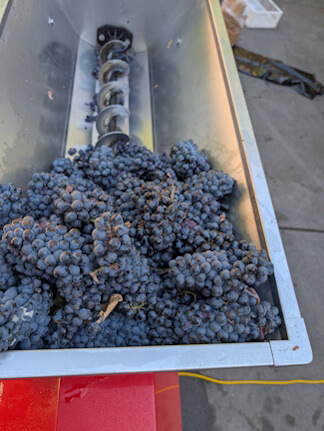
Our procedure is two members of the group rent a truck and drive from Durham NC to Ashland VA (just north of Richmond) on a Friday. The truck is loaded, and they drive back to Durham, where the grapes & juice are unloaded into the host’s garage.
This was completed by 5:30 PM last night. This morning at 10:00 AM, the temperature of the grapes was about 50 F (10 C). If the temperature is at or above 60 F (15.6 C) tomorrow I’ll inoculate.
The juice buckets don’t require any effort at crush time, as they are just juice.
The buckets have a vent in the lid, which relieves pressure if fermentation starts. It also allows juice to escape when the juice expands as temperature rises. This can produce a mess. We solved that problem with painter’s plastic, which we put into the vehicle so it’s under and around the buckets. Any mess is on the plastic.
Yes, we learned to do this by experience. Cleaning juice out of seat fabric is not fun.
Once we got home, we unloaded everything into the cellar.
The Verdicchio buckets were poured into standard 7.9 US gallon (30 liter) fermenters. There’s not sufficient room in the original buckets to allow for fermentation.
We got the Baco Noir pomace out of the freezer and put into 20 gallon Brutes. Then we poured a bucket of Pinot Noir over the pomace.
I had intended to defrost the pomace first, but forgot. It will defrost. If the temperature is not above 60 F tomorrow, I’ll check again on Monday.
After all that was done, we needed a drink!
Following the cleanup after crush, we taste wines everyone has brought. It’s typically wines made from previous vintages of the California grapes. This is a lot of fun, but I always taste sparingly, as I am driving.
This year the winner was a Koch Ranch Cabernet Sauvignon. This is the most expensive CS available to us, running $120/lug in recent years, $125 this year. WAY too rich for my wallet. The wine is REALLY good, but my grapes typically run $52 to $68 per lug, and the Koch Ranch is not yearly twice as better. But it was fun to drink.
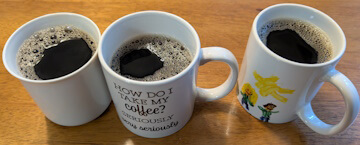
I brought a bottle of the Beta FWK Ultima Zinfandel I started in December 2023. No one realized it was a kit until I told them. I was looking for real feedback. Based upon comments, it was the #2 wine of the tasting.
Oh, we drink we had when we got home? It wasn’t wine …
11/01/2025
It’s been a busy week, so I have not updated this post. This section will include information from multiple days.
On Sunday (10/26) everything was too cold, so I did not inoculate.
On Monday (10/27) I inoculated. I used GoFerm Sterol Flash for all starters, which were:
- Verdicchio: 1 packet QA23 for each fermenter (23 liters each).
- Pinotage: 2 packets RC-212 for one fermenter (4 lugs) and 5 tsp Bravo for the other (also 4 lugs).
- Pinot Noir: Although the pomace has Avante and Bravo in it, I chose to make a starter of each, adding to the respective fermenters.
The Verdicchio had started to ferment, but just barely (1.083) so I called it 1.086 as a start.
The Pinot Noir was also fermenting, down to 1.068. I emailed Gino Pinto (vendor) and the OG was 1.083. I’m sure the Avante and Bravo took over.
The Pinotage? SG is 1.122. Yeah, that high. The likely result is 16.5% ABV, which is WAY too hot.
I looked at options, and decided to water it back 5%, meaning I’d add 2 liters of water to each fermenter. That should drop the ABV to 14.5%, which is more manageable.
Additionally, I considered blending in other wines, including this year’s Baco Noir (11% ABV) or last year’s Chambourcin and/or Chelois (13%). Beth suggested going with Chelois, as it’s a good blender, and Baco Noir may be overpowering. So that’s on the table.
On Wednesday (10/29), everything is fermenting, but doing so slowly. The GoFerm may do good things for the yeast, but it doesn’t produce a large colony like a 12 hour starter does.
On Friday (10/31), the Pinotage was down to 1.060, so I added my mix of Fermax/DAP. Especially with the RC-212 batch, I want sufficient nutrient to avoid H2S.
The Verdicchio was down to 1.052, so it received nutrient as well. The surprise was the Pinot Noir, which was down to 1.002. It’s essentially done fermenting, so no need for nutrient.
In hindsight, the starters for the Pinot Noir was unnecessary. The yeast in the Baco Noir pomace survived freezing and really kicked into gear!
This afternoon (11/01), I added 2 liters of water to each Pinotage fermenter. SG was 1.022 before, and after mixing as well as I could, it was 1.020. I expected it to drop more, so either I didn’t mix well enough, or I did the calculation for water wrong. I’ll re-check to see if I made an math error.
We had planned to press today, but with last night’s SG readings, we’re looking at Tuesday or Wednesday of next week. Maybe Friday or Saturday.
11/09/2025
just a stub, need to fill in.
11/11/2025
I checked the SG on the Pinotage in the demijohn this morning. I’m pleased to see it dropped from 1.002 to 0.997. I’m fairly certain the RC-212 and Bravo strains reached their ABV tolerance and stopped. Adding the EC-1118 is finishing the ferment.
We also have the 19 liter carboy of Pinotage. I’m going to remove 1/2 liter wine from each container and swap them. This will provide an influx of EC-1118 into the carboy, so it should complete fermentation as well before it’s ready for barrel in a few weeks.
